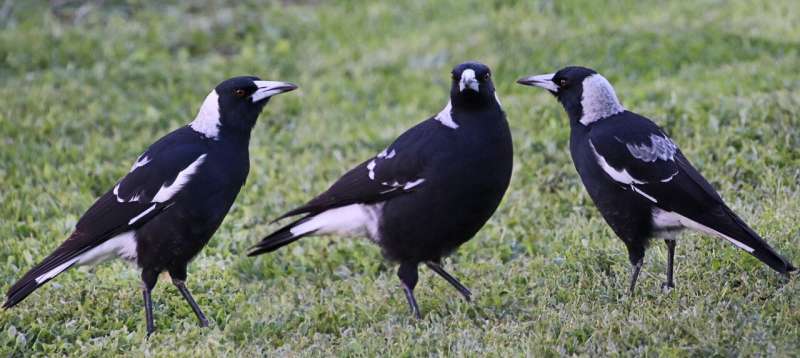Magpies can identify intruder calls and quantities of food, research reveals

Sadie Harley
scientific editor

Andrew Zinin
lead editor

New research has shown for the first time that magpies can distinguish between the number of callers when played recordings of intruder magpies.
Researchers from The University of Western Australia's Center of Evolutionary Biology had already established in a published earlier in 2025 that magpies could discriminate between different quantities of food.
This time the researchers, led by Dr. Grace Blackburn, wanted to find out if the magpies were just as good at distinguishing quantity when it came to auditory signals from other birds, and whether the skills were related.
"Being able to distinguish how many intruders may be nearby is an important skill for animals, who then need to assess whether they could win if it came down to a fight," Dr. Blackburn said.
"We wanted to find out whether magpies could do this and, if so, whether the cognitive skill needed to do so was related in any way to their ability to discriminate between different quantities of food."
In the new study, the team again invited magpies to choose between different quantities of food, finding magpies were able to distinguish between two versus three, two versus four, and two versus five pieces of cheese.
They later played the same magpies recordings of one, two or three intruders calling, then observed the level of singing and vigilance the magpies displayed in response.
They noticed the magpies spent more time vigilant—signaled by an erect posture and scanning the environment—when there were more callers than when there was only one.
"It was really exciting to see that they can tell if the song is of one individual versus two or three, which is very important for them when it comes to intergroup competition," Dr. Blackburn said.
But when the researchers dug further into the responses of individual magpies to see whether there was a link between how they performed at the two different tasks, the results were unexpected.
"We thought the birds that were better at discriminating between, say, five pieces of cheese and two pieces of cheese would also be better at discriminating between three callers and one caller—that they would respond with more vigilance to three callers because it was the bigger threat," Dr. Blackburn said.
"Instead, we found that while magpies were more vigilant when there were more callers, those who performed better on the food task spent less time vigilant following the three-caller playback than magpies that weren't as good at identifying larger quantities of food.
"So we did find a correlation, but it was the opposite of what we expected and we aren't completely sure why."
In a paper published in the journal , the researchers discuss potential explanations for the unexpected result.
This include the possibility that the magpies who were better at the food-based cognitive task and spent less time vigilant may simply be faster at assessing the low threat level posed by acoustic signals alone, versus acoustic plus visual evidence of intruders.
Alternatively, the more vigilant magpies may have more experience of conflict and intergroup interaction, and thus have heightened stress levels that made them more alert to perceived threat.
"Given stress is known to affect cognitive performance, this could also explain why these individuals weren't as good at the food task," Dr. Blackburn said.
In a third theory, the researchers thought the cognitive abilities used in the two tasks may be underpinned by different domains, with some individuals simply more adept in one domain, such as visual processing over another, such as auditory processing.
"More research is required to understand the negative relationship we observed, but the fact there is any link between performance on the tasks is significant," Dr. Blackburn said.
"Our findings not only add to the body of work documenting quantity discrimination abilities across species but also provide some of the first evidence that performance in spontaneous quantity discrimination tasks can be related to ecologically relevant situations."
More information: Grace Blackburn et al, Response to intruder number is related to spontaneous quantity discrimination performance in a wild bird, Behavioral Ecology (2025).
Holly Hunter et al, Group size affects spontaneous quantity discrimination performance in wild Western Australian magpies (Gymnorhina tibicen dorsalis), Animal Cognition (2025).
Journal information: Behavioral Ecology , Animal Cognition , Behavioural Ecology
Provided by University of Western Australia



















